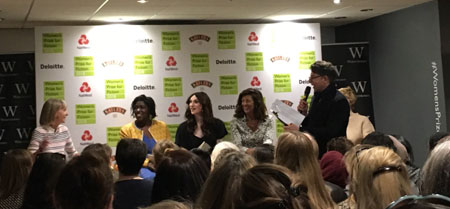It was my birthday last weekend and my wonderful partner surprised me with a trip to the village of Haworth – the famous home of the Brontë sisters! This was an incredibly thoughtful treat especially since I’ve been reading the Brontës more in recent years as part of the celebrations marking the bicentenaries of the births of Charlotte, Branwell, Emily and Anne. I love visiting these historic locations and museums such as a trip we took to Virginia Woolf’s residence Monk’s House a few years ago. And anyone who has read the Brontës knows the important role the location and environment plays in the their novels – as Kate Bush so aptly describes singing about “the wiley, windy moors”. So it felt really special to see this landscape myself as an immersive experience and to discover how Haworth has capitalized on its famous literary sisters since the 1800s. It’s an endearing mixture of quaint English village and a kitch kind of Brontëland.
While I know it’s geeky, I got fully on board with this as we stayed in Dr McCracken’s bedroom in the Ashmount Country House (the old residence of Charlotte Brontë’s doctor), bought baked goods from the Villette coffee house, toured the Brontë Parsonage Museum and roamed for hours through the moors on public paths that the Brontës themselves once walked. I resisted indulging in drinking any of the Brontë beers offered at one pub! All this really brought the atmosphere of the novels alive and even if you haven’t read the novels the landscape is absolutely beautiful. The museum is fascinating and so thoughtfully presented with many of the rooms containing the Brontës’ actual furniture and many displays of their clothing, letters, artwork by Charlotte and the writing boxes that belonged to each of the sisters. In addition, there are many explanatory notices about the Brontë family, the context of the sisters’ publications, the tragedies of their early deaths (there’s even a morbid bracelet on display that Charlotte made from the hair of her sisters Emily and Anne after their deaths!) and information about the village life itself. Apparently disease was so prevalent in this area of the country during the Brontës’ time that the average life expectancy of villagers was only 25 years!
Walking through the moors has its own special pleasure and the atmosphere was heightened on the weekend we visited since the weather was so changeable. The skies frequently switched from stormy grey to blazing sunshine in the space of a few moments so it became confusing to know whether we should be cowering under umbrellas or stripping down to our t-shirts. The first stop we went to was the rather grandly labelled Brontë Falls (more like a trickling stream than a waterfall) and from there we ventured onto Top Withens, a dilapidated farmhouse which is widely considered to be the inspiration for the house in “Wuthering Heights”. Although there’s no actual evidence that Emily based her fictional house on this location, it’s easy to make the assumption it inspired her for its remoteness and position on quite a weather-beaten hillside.
Walking along the paths there’s gorgeous rocky terrain covered in colourful heather, fields of grazing sheep and carved stone books periodically appear along the way. As part of the #Bronte200 celebrations in recent years, there are also four specially commissioned stones dedicated to each sister and the Brontës as a whole with original poems written by Carol Ann Duffy, Jeanette Winterson, Jackie Kay and Kate Bush. These are set in different remote locations and it’d require a 9-mile walk to see them all. We only stopped to see The Anne Stone (written by Jackie Kay) which is conveniently set next to the Brontë Parsonage Museum. And we also took the perilous journey to see The Emily Stone (written by Kate Bush) which is set in a particularly wild part of the countryside that Emily apparently loved to roam. Although we bought a special map marking the location of each stone The Emily Stone is very hard to find (even though it’s on Google maps). Kate Bush’s words are carved into the cliffside of Ogden Kirk located near a deep gully. Once you get to the location there are no signs directing you to where the stone actually sits. Instead we had to clamber down the steep cliffside to find it. I’m sure many hikers miss this stone because it’s so hard to locate. Nevertheless, it made quite a fun adventure.
I’ve not read any books about the Brontës as a whole or any bios on the individual sisters. It’s not surprising they’ve become so legendary as their story is so irresistible and grimly marked by their early deaths. But I find it curious how many people like to “pick sides” as if it’s necessary to pick one sister as a favourite. The museum gift shop even sells badges advocating your support for Team Charlotte, Team Emily or Team Anne. I suppose the tone of their books marks distinct personality types so people feel inclined to “cheer” for one sister or another. I’m glad to have read a novel by each sister including “Jane Eyre”, “Wuthering Heights” and “Agnes Grey”. Out of these probably “Jane Eyre” is my favourite but I feel more spiritually aligned with Emily Brontë. Please let me know if you have recommendations of which other books by the Brontës I should read or if you have any good suggestions for nonfiction about the Brontës.
I loved this weekend trip and would heartily recommend visiting the village. While you can get a train to Haworth, we rented a car after getting a train to Leeds since this makes it much easier to travel around the area and venture out to some of the more remote parts of the moors without hiking for hours on end. Let me know if you’ve ever gone to Haworth or if you’re a Brontë fan what your favourite book is.












